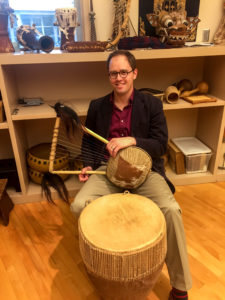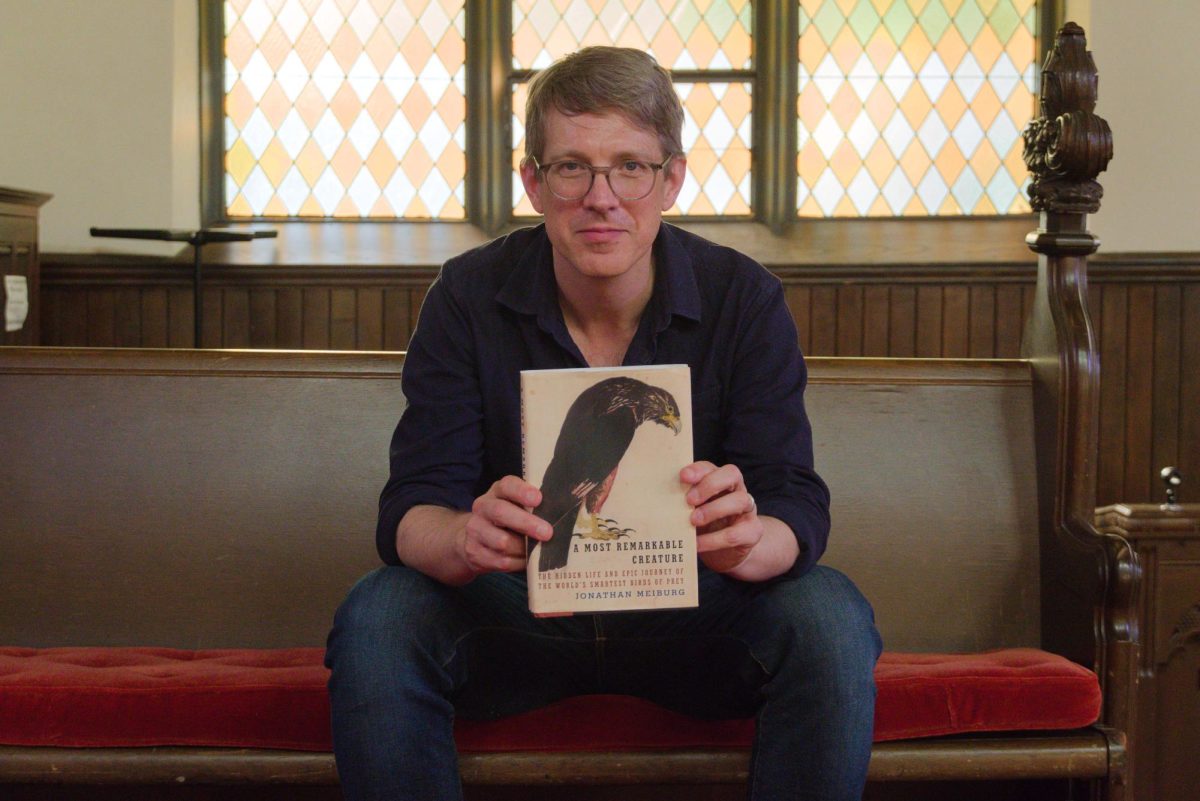
This semester, Professor Peter Hoesing, Music started Grinnell’s first Ugandan Music Ensemble. The group meets on Monday afternoons to study a variety of instruments and dance. The S&B’s Nora Coghlan sat down with Hoesing and group member Nyx Hauth ’19 to talk about the unique experience of playing in music ensembles at Grinnell.
The S&B: How did you get into Ugandan music and how did the ensemble start at Grinnell?
Peter Hoesing: When I was a graduate student, this guy came from Uganda and was part of my program at Florida State and introduced me to Ugandan music. I was playing in the African music and dance ensemble that semester and I had just really had a good experience with it. I first saw and heard him play this instrument, called the endongo, and it had a buzzy sound, and I was just fascinated with the rhythm of this instrument and the timbre of it. So I asked him to teach me all about these string instruments. I had a background as a drummer and my previous conception of African music was very heavy percussion influenced, and this was a new way of looking at African music. So I got really interested in the string music at that point. Then I spent the next 10 years on my own project about Ugandan music that has to do with music and healing and ritual … but while I was doing that and while I was going back and forth and while we were grad students we always made music together. So I studied this instrument with him, the amadinda … which is the key percussion instrument that looks like a xylophone, with him and with my advisor one semester and I studied this instrument with him privately over the course of several semesters.
The S&B: Are there any other instruments in the ensemble?
PH: There are other instruments in the ensemble. You have endongo, there’s adungu which is a thumb piano, there’s a single stringed fiddle called the endingidi … These are really different instruments and they are all from different regions of Uganda, and they came into the royal court in the southern part of the country in a kingdom called Buganda because the king was hearing about these musicians from other regions and, for example this one is from the eastern region, and he heard about this guy playing entongoli … and he said bring that … thing into the court I want to hear more of that. The same goes for this instrument, which is in several regions across the north and northwest, same with this harp, which is from the northern region called Acholiland. This [harp] is the only instrument that is tuned like a western instrument would be. It’s tuned diatonically. It’s only in one key, but as long as you’re playing in that key with another instrument like a piano or guitar, you can play with this instrument. Other instruments are tuned usually to some kind of five note scale. So the instruments are really diverse, and then of course there’s drums. The main royal ensemble for court music was traditionally … two drums and then the tall [drum] and a little drum for a dance called Bakisimba which we do a lot of. A lot of the music that we’re playing this semester is Bakisimba based, and that music is related to the staple food for this southern central kingdom, which is matoke. When you say Bakisimba it means that planted it, this banana … and that’s because people brought that plant into Uganda and it became kind of a core part of Kiganda identity. That’s kind of a general overview of the instruments we’re dealing with and a little bit about the dance … We’re not doing a lot of dance right now because we need some more people.
The S&B: How many members do you have right now?
PH: It’s just Nyx and me … We have somebody else who came to our open rehearsal last week who was maybe going to join us today, and then there’s one [professor] in the philosophy department who joins us from time to time.
The S&B: What initially drew you to the ensemble? Why did you decide to join?
Nyx Hauth: I was just kind of flipping through all the courses that were offered, and I had heard that for the music ensembles now, you could take them for credit without having an overload, and it sounded cool. I didn’t really know anything, honestly, about Uganda or Ugandan music but it sounded interesting.
PH: That’s kind of a fun feature of this ensemble and early music and world music ensembles here at Grinnell generally, is that you don’t necessarily have to have any experience with the instruments or the music to walk into an ensemble and play.
NH: Or with music in general.
PH: Yeah, right. So that’s attractive for students who just want to do something different, they want a break from their normal shtick.
The S&B: What does a normal rehearsal typically look like?
NH: At a normal rehearsal when we had more people we would each be playing a different instrument, and people would switch off between instruments, a bit, but it was a little bit more set in the instruments, but now since it’s just us two we tend to play more.
PH: Yeah, Nyx moves around quite a bit because we have all that latitude, but yeah typically in a larger ensemble setting people get interested in particular instruments and they specialize in them.
NH: It would start with us just making sure that all the instruments are in tune right, and then just kind of in a circle starting up with the tune. It usually starts with drums and then the other instruments come in and then there was singing. So it’s kind of just like a jam session.
PH: Yeah, like if I’m to introduce a new tune, I usually get people to try and sing it first, tell them something about the words and then add things piece by piece. In a bigger ensemble setting I have in the past introduced an … instrumental part to the whole group and said ‘okay, whoever is interested in playing that instrumental part, you go off in the corner and you work on that and we’ll deal with this other thing,’ and kind of break people up and do sectionals in that way. But again, since it’s just Nyx and me we took a little different approach this semester. We’re using a loop pedal so that we lay down a repetitive track and then improvise over that, is what we did on one tune. We’re doing some things that I haven’t done with this ensemble before which is kind of fun.
The S&B: Do you use written music at all?
PH: No, we don’t. I teach everything basically by rote. Different people have different ways of writing this stuff down and because these ensembles tend to attract a really diverse group in terms of musical experience, I encourage people to write them down in whatever way works for them … For Nyx, what works a lot of times is to record something and then use that as a reference later, and that’s fine. If people want to do that I’m fine with that and they can record in rehearsal. Other folks sometimes have numbers that they use, like that works really well for amadinda because you’ve got … 12 key amadinda … and so people use numbers to write down something I’m playing here … but the point in the end always turns out to be memorizing it so you don’t need the notation. So if it works for you not to write stuff down, you can cut out the middle man and that’s fine.
The S&B: Did you have any musical experience before you joined the group?
NH: So, I had musical experience, but not traditional or kind of … music theory background. I’ve played the harp for like 10 years, but I’ve always learned by ear, but I’m working on reading music. I think most of the ensembles are pretty accommodating for different learning styles.


















































